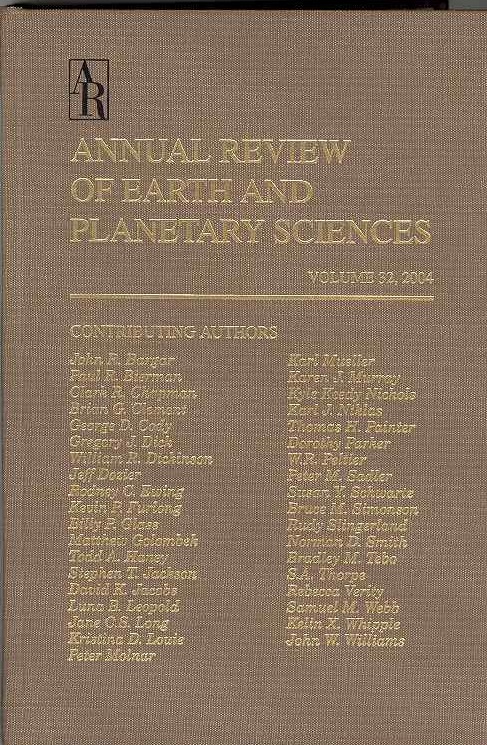2020年木卫一的观测前景
IF 11.3
1区 地球科学
Q1 ASTRONOMY & ASTROPHYSICS
Annual Review of Earth and Planetary Sciences
Pub Date : 2021-05-30
DOI:10.1146/ANNUREV-EARTH-082420-095244
引用次数: 8
摘要
木星的伽利略卫星木卫一是太阳系中最引人注目的物体之一。木卫一在与木卫二和木卫三的轨道共振中经历的潮汐加热导致了一个富含活性硅酸盐火山作用的天体。在过去的几十年里,人们通过地面和地球轨道望远镜以及几艘宇宙飞船对木卫一进行了观测。在这篇综述中,我们总结了自伽利略时代以来我们对木卫一及其环境的物理和化学过程的理解所取得的进展。在8到10米的大型望远镜上使用自适应光学技术已经彻底改变了天文科学。由此产生的不断增加的数据库,绘制了木卫一不同火山的大小、风格和空间分布,提高了我们对木卫一内部结构、可能组成和潮汐加热过程的理解。此外,利用这些大型光学/红外望远镜和阿塔卡马大型毫米/亚毫米阵列获得的木卫一大气的新观测结果揭示了火山羽流的存在,(有时)木卫一大气在日食期间几乎坍塌,以及羽流与升华大气的相互作用。自伽利略时代以来,已经收集了大量关于木卫一的紫外、中至近红外和无线电波长的新数据集。▪新的数据和模型告诉我们关于潮汐加热、地表性质和岩浆组成的信息——尽管关键问题仍然存在。▪大气观测表明一个主要的升华支持成分,并加强了隐形火山活动的存在。▪火山羽流的观测显示了高气体速度(高达~ 1 km/s)及其对木卫一大气的影响。《地球与行星科学年度评论》第49卷的最终在线出版日期预计为2021年5月。修订后的估计数请参阅http://www.annualreviews.org/page/journal/pubdates。本文章由计算机程序翻译,如有差异,请以英文原文为准。
A 2020 Observational Perspective of Io
Jupiter's Galilean satellite Io is one of the most remarkable objects in our Solar System. The tidal heating Io undergoes through its orbital resonance with Europa and Ganymede has resulted in a body rich in active silicate volcanism. Over the past decades, Io has been observed from ground-based and Earth-orbiting telescopes and by several spacecraft. In this review we summarize the progress made toward our understanding of the physical and chemical processes related to Io and its environment since the Galileo era. Io science has been revolutionized by the use of adaptive optics techniques on large, 8- to 10-m telescopes. The resultant ever-increasing database, mapping the size, style, and spatial distribution of Io's diverse volcanoes, has improved our understanding of Io's interior structure, its likely composition, and the tidal heating process. Additionally, new observations of Io's atmosphere obtained with these large optical/infrared telescopes and the Atacama Large Millimeter/submillimeter Array reveal the presence of volcanic plumes, the (at times) near-collapse of Io's atmosphere during eclipse, and the interactions of plumes with the sublimation atmosphere. ▪ Extensive new data sets of Io at ultraviolet, mid- to near-infrared, and radio wavelengths have been gathered since the Galileo era. ▪ New data and models inform us about tidal heating, surface properties, and magma composition across Io—although key questions remain. ▪ Atmospheric observations indicate a dominant sublimation-supported component and reinforce the presence of stealth volcanism. ▪ Observations of volcanic plumes show high gas velocities (up to ∼1 km/s) and their effect on Io's atmosphere. Expected final online publication date for the Annual Review of Earth and Planetary Sciences, Volume 49 is May 2021. Please see http://www.annualreviews.org/page/journal/pubdates for revised estimates.
求助全文
通过发布文献求助,成功后即可免费获取论文全文。
去求助
来源期刊

Annual Review of Earth and Planetary Sciences
地学天文-地球科学综合
CiteScore
25.10
自引率
0.00%
发文量
25
期刊介绍:
Since its establishment in 1973, the Annual Review of Earth and Planetary Sciences has been dedicated to providing comprehensive coverage of advancements in the field. This esteemed publication examines various aspects of earth and planetary sciences, encompassing climate, environment, geological hazards, planet formation, and the evolution of life. To ensure wider accessibility, the latest volume of the journal has transitioned from a gated model to open access through the Subscribe to Open program by Annual Reviews. Consequently, all articles published in this volume are now available under the Creative Commons Attribution (CC BY) license.
 求助内容:
求助内容: 应助结果提醒方式:
应助结果提醒方式:


